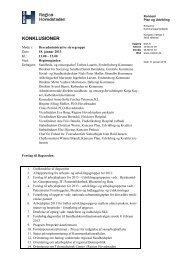Territorial Review Copenhagen - Region Hovedstaden
Territorial Review Copenhagen - Region Hovedstaden
Territorial Review Copenhagen - Region Hovedstaden
Create successful ePaper yourself
Turn your PDF publications into a flip-book with our unique Google optimized e-Paper software.
182<br />
A wide range of environmental initiatives could be pursued to bolster<br />
<strong>Copenhagen</strong>‘s sustainability. These span sustainable transport, urban<br />
ecology, energy conservation and environmental governance. To avoid a<br />
―wish list‖ approach, the implications of these improvements would have to<br />
be rigorously tested and compared to one another beforehand, using<br />
techniques developed in environmental and natural resource economics.<br />
This might be coupled with methodologies that are attuned to political<br />
conditions and the risk management from climate change, such as those<br />
developed in the City of London‘s Climate Change Adaptation Strategy<br />
(2007). Similarly, local governments might more carefully weigh their<br />
adoption of environmental projects by taking advantage of the work done at<br />
Eurostat, especially its sustainable development indicators (Eurostat, 2007).<br />
Finally, initiatives should strengthen existing environmental collaborations,<br />
such as the Dogme 2000 co-operation between the City of <strong>Copenhagen</strong> and<br />
six other municipalities. 43<br />
Improving sustainable transport and bicycle planning<br />
A large number of low-cost sustainable transit solutions might be<br />
considered to reduce single occupant vehicles and carbon emissions from<br />
automobile use. Though many policy makers in <strong>Copenhagen</strong> focus on<br />
increasing the modal share of bicycle use or public transit, a wide number of<br />
alternative urban transport management solutions may also reduce air<br />
pollution. Ride sharing, for example, encourages residents to use carpooling<br />
and vanpooling rather than drive alone. While carpooling uses drivers‘ own<br />
vehicles, vanpooling utilises vans that are usually owned by an organisation<br />
– a business, non-profit or government agency – and made available for<br />
commuting. Ride-share programs typically provide carpool matching,<br />
vanpool sponsorship, marketing programs, and incentives to reduce driving.<br />
These programs often succeed when employers offer financial incentives<br />
such as a cash payment to employees who carpool or a voucher that covers<br />
vanpool fees. Other policies that might be considered include car-sharing<br />
and charging the most active drivers through mileage-based registration or<br />
mileage-based emissions fees. Though modal share statistics would not<br />
indicate gains from these initiatives – an equal or larger amount of people<br />
would be commuting by cars – benefits would be illustrated through<br />
transportation fuel consumption, vehicle pollution emissions and average<br />
commute time (Litman, 2007).<br />
<strong>Copenhagen</strong>ers would benefit from an extension of the central city‘s<br />
well-designed pedestrian network to outlying areas. Compared to the<br />
central city, there is a relative dearth of high quality urban spaces in<br />
peripheral neighbourhoods. The City‘s Traffic Plan could better support<br />
pedestrian improvements to these areas by improved lighting, building

















